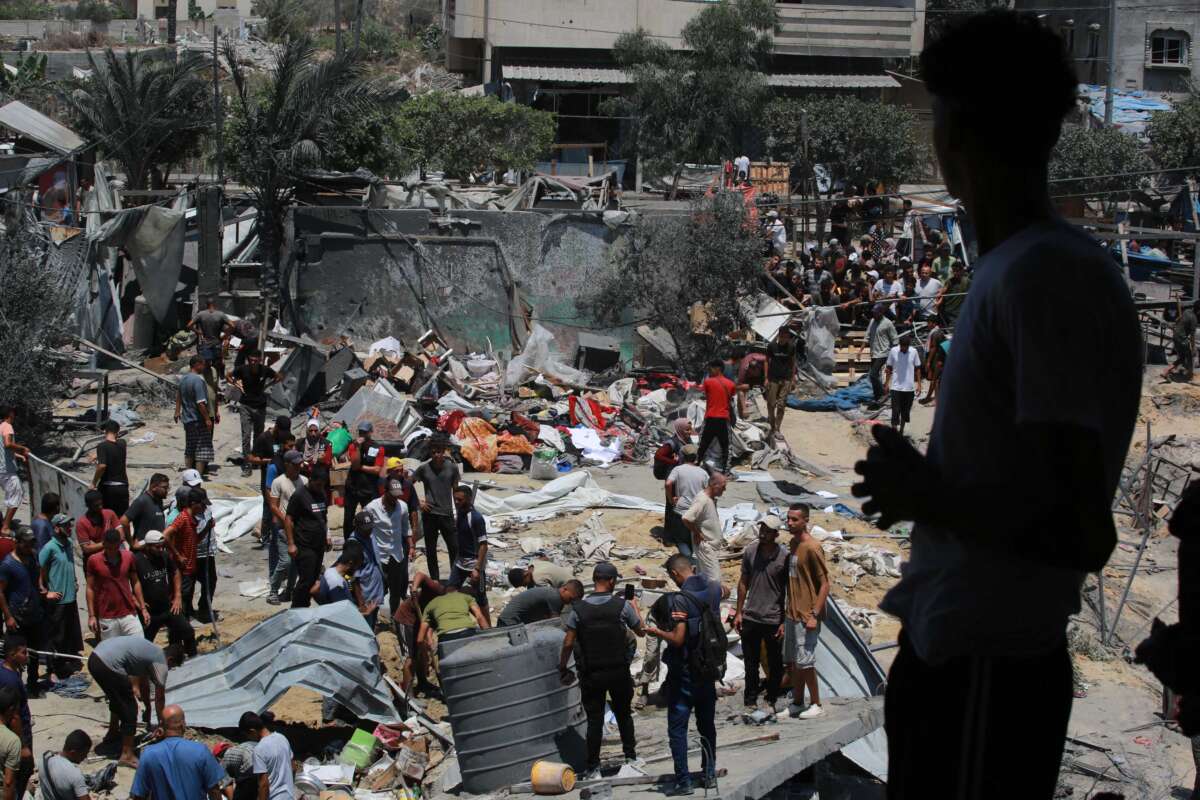Just over two months ago, Israel forced more than a million Palestinians who were taking shelter in southern Gaza to flee, once again, to an area it designated as a “humanitarian safe zone” — an area that the Israeli military has since attacked at least 10 times, new research finds.
According to London research group Forensic Architecture, the area in Al-Mawasi now sheltering thousands of Palestinians has been subject to Israeli attacks since May 6, when Israeli officials first delineated the “safe” zone.
The attacks started as early as two weeks after Israel forced Palestinians to flee to the area, a desert region with essentially no infrastructure, laying waste to tents and makeshift shelters set up to house people who Israel has displaced time and again in the past nine months.
“As with its relentless targeting of hospitals, Israel’s regular attacks on the so-called ‘humanitarian zone’ in al-Mawasi threaten to normalise such flagrant violations of international law,” Forensic Architecture wrote on social media. “The deadly strike on Saturday is just one in a series of repeated attacks on the designated humanitarian zone: we have mapped 10 attacks since 6 May.”
These findings contradict Israel’s claims that Al-Mawasi — and other supposed “safe zones” in Gaza — are exempt from the Israeli military’s campaign of “total annihilation.” They also demonstrate Israel’s strategy of forcing Palestinians into smaller and smaller areas in Gaza and then bombing those areas.
Israel’s attack on the Al-Mawasi “safe” zone on Saturday, in which the military dropped 8 2,000-pound bombs on a civilian area, killed at least 90 Palestinians and injured 300 more, officials reported. At least one of the bombs dropped was made in the U.S.
Those sheltering in the “safe” zone during the massacre included desperate families who had been forced to evacuate multiple times since October, and at least one survivor of the 1948 Nakba.
Survivors of the massacre describe scenes of horror as Israel’s shells rained down — children with severed limbs, people beheaded, and shrapnel, blood, and body parts flying everywhere.
Just days after, Israel unleashed another set of bombs on Al-Mawasi on Tuesday, killing at least 17 Palestinians.
At least two of these attacks on the “safe” zone have used U.S. bombs. An Israeli strike on May 26 that killed at least 45 people and injured 250 more used two Boeing-made bombs on a camp for displaced Palestinians.
These attacks on the explicitly designated “safe” zone come as Israel has relentlessly attacked other areas of Gaza in violation of international humanitarian law, which forbids targeting civilian infrastructure.
The UN reported on Wednesday, for instance, that it has recorded eight attacks on schools in Gaza in the past 10 days, including six UN schools. This includes an Israeli attack on a UN school in Nuseirat refugee camp on Tuesday, in which two Israeli strikes killed 20 people in the facility, now a shelter for displaced people.
The World Health Organization also reported that the Israeli military has attacked health care facilities in Gaza over 1,000 times since October — part of Israel’s systematic campaign to destroy all infrastructure essential to life in Gaza.
Our most important fundraising appeal of the year
December is the most critical time of year for Truthout, because our nonprofit news is funded almost entirely by individual donations from readers like you. So before you navigate away, we ask that you take just a second to support Truthout with a tax-deductible donation.
This year is a little different. We are up against a far-reaching, wide-scale attack on press freedom coming from the Trump administration. 2025 was a year of frightening censorship, news industry corporate consolidation, and worsening financial conditions for progressive nonprofits across the board.
We can only resist Trump’s agenda by cultivating a strong base of support. The right-wing mediasphere is funded comfortably by billionaire owners and venture capitalist philanthropists. At Truthout, we have you.
We’ve set an ambitious target for our year-end campaign — a goal of $250,000 to keep up our fight against authoritarianism in 2026. Please take a meaningful action in this fight: make a one-time or monthly donation to Truthout before December 31. If you have the means, please dig deep.
